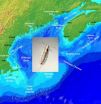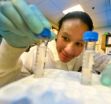(Press-News.org) EAST LANSING, Mich. — Lab success doesn't always translate to real-world success. A team of Michigan State University scientists, however, has invented a new technology that increases the odds of helping algae-based biofuels cross that gap and come closer to reality.
The current issue of Algal Research showcases the team's invention — the environmental photobioreactor. The ePBR system is the world's first standard algae growing platform, one that simulates dynamic natural environments.
Simply put, ePBR is a pond in a jar that helps identify, cultivate and test algal strains that have the potential to make the leap from lab to pond, proliferate in real-world, real-pond settings and produce the most oil.
Many scientists around the globe are looking for strains of algae that could become a sustainable source of alternative energy. A vexing problem they face, however, is that algal strains that perform well in labs often get stomped when it's time to scale-up the experiment, said Ben Lucker, MSU research associate.
"It's like training elementary kids to be really good pingpong players," he said. "But then they take the kids and throw them into a football game against professional players; in those settings, they simply can't compete at all."
The ePBRs, which subsequently help make algae biofuel research more desirable to investors, were the brainchild of David Kramer, Hannah Distinguished Professor of Biochemistry and Molecular Biology at MSU.
Kramer's lab is like no other. Even though it's housed among other plant biologists, it could be mistaken for an electronics factory. The benches are covered with wires, soldering irons and printed circuit boards. There are even few early prototypes that provide a history of ePBR's progress.
The latest models glow green and whir quietly as they test various strains. By allowing scientists to duplicate natural settings in a lab, ePBRs eliminate many variables before scaling up. The bioreactors are about the size of coffee makers and can induce changes in light, temperature, carbon dioxide, oxygen, evaporation, nutrient availability and more.
The ePBR system also can duplicate and confirm results from experiments conducted anywhere in the world. It replaces home-built growing platforms made from flasks, tubing, aluminum foil and grow lights and gives researchers a tool that can consistently replicate conditions and reproduce results, Lucker said.
The potential of ePBRs has already inspired the launch of a company, Phenometrics, an MSU spinoff headquartered in Lansing. The company is merely two years old, but steady orders for the bioreactors have the company already running in the black.
INFORMATION:
Additional MSU scientists who were part of this study include Christopher Hall and Robert Zegarac.
Kramer's work is funded in part by the U.S. Department of Energy and MSU AgBioResearch.
Michigan State University has been working to advance the common good in uncommon ways for more than 150 years. One of the top research universities in the world, MSU focuses its vast resources on creating solutions to some of the world's most pressing challenges, while providing life-changing opportunities to a diverse and inclusive academic community through more than 200 programs of study in 17 degree-granting colleges.
For MSU news on the Web, go to MSUToday. Follow MSU News on Twitter at twitter.com/MSUnews.
MSU advances algae's viability as a biofuel
2014-02-26
ELSE PRESS RELEASES FROM THIS DATE:
Where have all the codfish gone?
2014-02-26
The mega-decline in cod and other fisheries across the North Atlantic Ocean threatens the livelihood of fishermen and communities in New England and Atlantic Canada. One suspect in the disappearance of cod and other groundfish is the food source for their young: a planktonic copepod crustacean, no larger than a grain of rice. Recent changes in local copepod populations have co-occurred with declines in fisheries elsewhere, such as the collapse of the cod fishery in Europe's North Sea.
For this and other reasons, Petra Lenz and Andrew Christie are among the scientists ...
Exercise, surgically removing belly fat improves cognition in obese, diabetic mice
2014-02-26
Augusta, Ga. – Cognitive decline that often accompanies obesity and diabetes can be reversed with regular exercise or surgical removal of belly fat, scientists report.
A drug already used to treat rheumatoid arthritis also helps obese/diabetic adult mice regain their ability to learn and comprehend, while transplanting belly fat to a normal mouse reduces those abilities, said Dr. Alexis M. Stranahan, neuroscientist at the Medical College of Georgia at Georgia Regents University.
Studies in humans and animals indicate that obesity and diabetes – which often go hand ...
WSU researchers say fear of death may curb youthful texting and driving
2014-02-26
PULLMAN, Wash.—While drivers tend to believe it is dangerous to text and drive, many say they can still do it safely. Now Washington State University researchers say drivers can be discouraged from the practice with public service announcements that evoke their fear of death in graphic terms.
Looking to curb what former U.S. Transportation Secretary Ray LaHood called "a national epidemic," WSU marketing professors Ioannis Kareklas and Darrel Muehling recently explored driver attitudes toward texting. They examined various ways to discourage texting while driving through ...
Software maps ambiguous names in texts to the right person
2014-02-26
This news release is available in German.
If a name is ambiguous and given without context, even humans struggle. When reading the last name "Merkel", people do not know if it refers to the Chancellor of Germany Angela Merkel or the famous soccer coach Max Merkel. It is a drawback for web search, too. Up to now, the programs can capture character strings like "Angela Merkel", but they do not pay attention to attributes like "German Chancellor" or "Germany's First Lady" at all. Even worse, after the word "Merkel" is entered, the search engines provide information about ...
Offshore wind farms could tame hurricanes before they reach land, Stanford-led study says
2014-02-26
For the past 24 years, Mark Z. Jacobson, a professor of civil and environmental engineering at Stanford, has been developing a complex computer model to study air pollution, energy, weather and climate. A recent application of the model has been to simulate the development of hurricanes. Another has been to determine how much energy wind turbines can extract from global wind currents.
In light of these recent model studies and in the aftermath of hurricanes Sandy and Katrina, he said, it was natural to wonder: What would happen if a hurricane encountered a large array ...
Research: Fructose not responsible for increase in non-alcoholic fatty liver disease
2014-02-26
TORONTO, Feb. 26, 2014—Non-alcoholic fatty liver disease is the most common chronic liver disease in developed countries, affecting up to 30 per cent of their populations.
Since the disease is closely linked to obesity and Type 2 diabetes, there's a growing debate in the medical community about whether diet plays a role in its development, specifically the consumption of fructose.
The possible link to non-alcoholic fatty liver disease has become the main criticism against fructose among those who believe there is something unique about the fructose molecule or the way ...
Climate change causes high, but predictable, extinction risks
2014-02-26
Judging the effects of climate change on extinction may be easier than previously thought, according to a paper published today in the journal Nature Climate Change.
Although widely used assessments of threatened species, such as the IUCN Red List, were not developed with the effects of climate change in mind, a study of 36 amphibian and reptile species endemic to the US has concluded that climate change may not be fundamentally different from other extinction threats in terms of identifying species in danger of extinction.
The new study, funded by NASA and led by Richard ...
Taming hurricanes
2014-02-26
Wind turbines placed in the ocean to generate electricity may have another major benefit: weakening hurricanes before the storms make landfall.
New research by the University of Delaware and Stanford University shows that an army of offshore wind turbines could reduce hurricanes' wind speeds, wave heights and flood-causing storm surge.
The findings, published online this week in Nature Climate Change, demonstrate for the first time that wind turbines can buffer damage to coastal cities during hurricanes.
"The little turbines can fight back the beast," said study ...
Pennsylvania high school takes action against distracted driving
2014-02-26
Pennsylvania high school takes action against distracted driving
Article provided by Rieders, Travis, Humphrey, Harris Waters & Waffenschmidt
Visit us at http://www.riederstravis.com
Distracted driving can take on many different forms. A driver can be defined as distracted if they are eating while driving, doing their makeup, changing the station on the radio or even just talking to another person in the car with them. However, one of the most dangerous distracted driving activities is texting and driving.
The dangers of texting and driving
According to ...
How reasonable must "reasonable suspicion" to enter a home be?
2014-02-26
How reasonable must "reasonable suspicion" to enter a home be?
Article provided by The Law Office of James M. Caramanica
Visit us at http://www.massfelonylawyer.com/
Under both federal and Massachusetts law, individuals have a right against unreasonable searches. This is especially true when the area to be searched is the home; courts have long held that an individual's home is particularly sacrosanct. In the Massachusetts Supreme Court's words, "In the home, ... all details are intimate details, because the entire area is held safe from prying government ...





